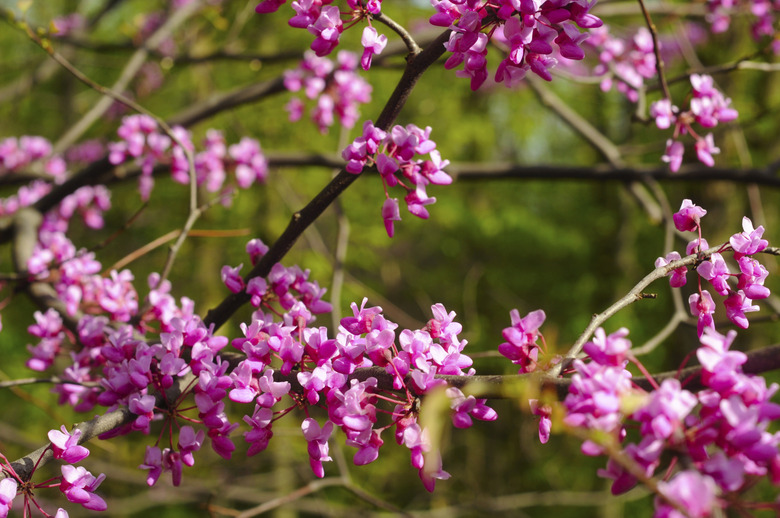How To Prune A Forest Pansy Redbud Tree
"Forest Pansy" redbud (Cercis canadensis "Forest Pansy") serves as a colorful alternative to other eastern redbud (Cercis canadensis) cultivars. This variety was discovered in the mid-1940s by Forest Nursery in Tennessee. Like other redbuds, "Forest Pansy" doesn't require much pruning or other maintenance once established, but does require pruning and attention when young. **To promote flower and growth development, prune directly after flowering; to control size and shape, prune while the tree is dormant in the winter.**
Step 1
"Forest Pansy's" distinctive characteristics from other redbuds include dark, purplish-green leaves and deeper, wine-red buds and blooms. Like the species, it often grows as a multi-trunk tree with a compact and vase-like habit. It tends to stay shorter than the species, reaching average heights between 12 and 18 feet. The "Forest Pansy" cultivar grows in U.S. Department of Agriculture plant hardiness zones 5 through 9, but may perform best in USDA zones 6 through 8; the eastern redbud species typically grows well in USDA zones 4 through 9.
Pruning: Tools
Step 1
In general, a handful of pruning tools is all you need to correctly and safely prune redbuds. Use pruning shears to cut branches up to 3/4-inch in diameter; small branches like this are common on very young redbuds. Use lopping shears for branches up to 1 1/2 inches in diameter and a pruning saw or chain saw for larger branches. For long branches, make multiple cuts to reduce the risk of injury. Always disinfect your pruning tools before and after cuts by dipping them in anti-bacterial household cleaners or spritzing with rubbing alcohol.
Step 2
- "Forest Pansy's" distinctive characteristics from other redbuds include dark, purplish-green leaves and deeper, wine-red buds and blooms.
- Use pruning shears to cut branches up to 3/4-inch in diameter; small branches like this are common on very young redbuds.
Pruning: Training
Step 1
When young, nearly every variety of redbud requires pruning to create a pleasing and strong shape, whether you want to maintain a multi-trunk tree or create a single-trunk tree. To form a single-trunk specimen as opposed to a multi-trunk tree, choose a central leader that is thick, straight and strong. Remove any branches that are more than one-half the diameter of the trunk to reduce the risk of branch breaking and splitting. Remove other low-growing branches that form trunks, making angled cuts just before the main trunk. Remove all branches that connect to single or multiple trunks with a V-shaped crotch; these strongly angled crotches will easily break or split, leaving room for disease.
Pruning: Disease Prevention
Step 1
Remove any dead, dying, diseased or broken branches as you find them. Once a branch is diseased, the chance of the fungal or other disease spreading throughout the redbud increases. Also remove any branches that have grown in a way that causes them to rub or otherwise touch other branches; rubbing can cause wounds which invite pests and disease. Always cut back to a lateral branch or the main trunk, leaving only a small, about 1-inch knob before the lateral branch or trunk. Canker is a serious disease of redbuds that often attacks unhealthy trees, wounds in redbuds or broken branches. Pruning out dead, dying or broken branches thoroughly increases your redbud's chance of survival and longevity. Redbud is particularly susceptible to wounds; make pruning cuts carefully and avoid damaging the tree with lawn mowers or other equipment.
Step 2
- When young, nearly every variety of redbud requires pruning to create a pleasing and strong shape, whether you want to maintain a multi-trunk tree or create a single-trunk tree.
- Remove all branches that connect to single or multiple trunks with a V-shaped crotch; these strongly angled crotches will easily break or split, leaving room for disease.
Pruning: Hazard
Step 1
Although "Forest Pansy" doesn't require pruning throughout its life as a part of regular maintenance, it is sometimes necessary to remove low-growing branches that prevent you from walking under the tree. This is particularly true in the case of redbuds planted near sidewalks. As always, remove branches back to a lateral or terminal branch or the trunk.
References
- HortScience: 'Ruby Falls' and 'Merlot' Redbuds
- Missouri Botanical Garden: Cercis Canadensis "Forest Pansy"
- University of Florida: USDA Forest Service: Cercis Canadensis "Forest Pansy"
- University of Nebraska-Lincoln Extension in Lancaster County: Pruning Tools – The Basics!
- Clemson Cooperative Extension: Redbud
- The University of Tennessee Institute of Agriculture: Best Management Practices for Pruning Landscape Trees, Shrubs and Ground Covers
